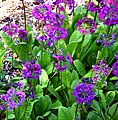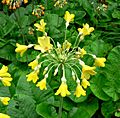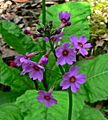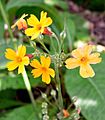Primula facts for kids
Quick facts for kids Primula |
|
|---|---|
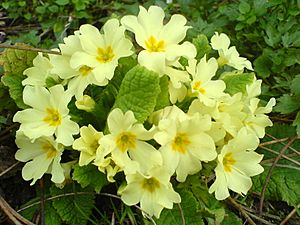 |
|
| Primula vulgaris | |
| Scientific classification | |
| Kingdom: | |
| (unranked): | |
| (unranked): | |
| (unranked): | |
| Order: | |
| Family: | |
| Genus: |
Primula
|
Primula is a group of about 400 to 500 types of small, low-growing plants. They are known for their beautiful flowers. Some common names for these plants include primrose, cowslip, and oxlip. They belong to a plant family called Primulaceae.
Many Primula species are grown in gardens because their flowers are so pretty. These plants naturally grow in cooler parts of the Northern Hemisphere, like Europe, Asia, and North America. You can also find them in tropical mountains in places like Ethiopia, Indonesia, and South America.
Most Primula plants bloom in the spring. Their flowers can be many colors, such as purple, yellow, red, pink, or white. They usually like places with some shade, not too much direct sunlight. Many types of Primula are also found in cold, high mountain areas.
The name Primula comes from a Latin word meaning "first." This is because these flowers are often among the first to open in the spring.
Some caterpillars, which are the young forms of butterflies and moths, eat Primula plants.
You might hear about different types of cultivated Primula. For example, "polyanthus" are often hybrids of P. elatior, while "primrose" usually refers to P. vulgaris hybrids.
How Primula Flowers Are Different
The common primrose, Primula vulgaris, has a special feature called heterostyly. This means its flowers come in two different shapes. These shapes are different in how long their pistil (the female part) and stamens (the male parts) are.
This difference in flower shape is linked to how the plant reproduces. It has a system that stops a flower from fertilizing itself or another flower of the same shape. This is called self-incompatibility.
There are two main flower shapes:
- Pin flowers: These have short stamens and a long pistil.
- Thrum flowers: These have long stamens and a short pistil.
The cool thing is that the length of the pistil in a pin flower is about the same as the length of the stamens in a thrum flower. And the length of the stamens in a pin flower is about the same as the pistil in a thrum flower. This clever system helps prevent the plant from fertilizing itself. Instead, it encourages pollen to move between different flower shapes, which helps the plant stay healthy and strong.
Almost all types of Primula have this heterostyly system. It's a very old feature of these plants.
Images for kids
See also
 In Spanish: Prímula para niños
In Spanish: Prímula para niños




